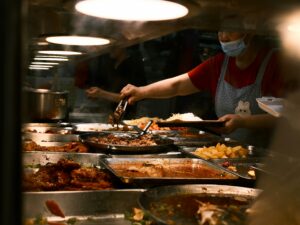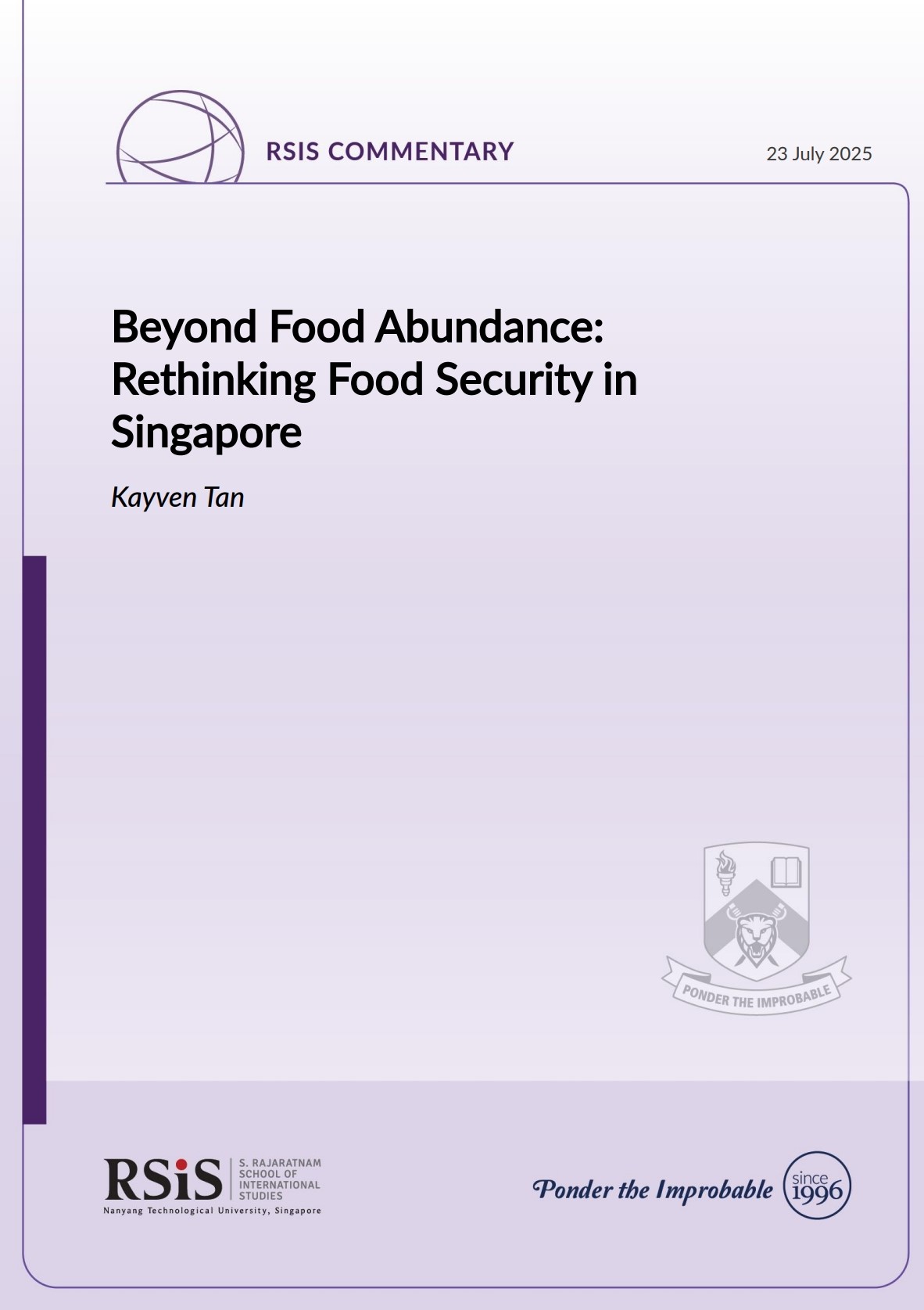23 July 2025
- RSIS
- Publication
- RSIS Publications
- Beyond Food Abundance: Rethinking Food Security in Singapore
SYNOPSIS
Singapore’s robust food supply resilience is well-known. Food security, however, could be complemented by greater attention to an often-overlooked and under-represented aspect in mainstream discourse – access. The challenges faced by food-insecure individuals underscore the need for a more comprehensive understanding of what food security truly entails.

COMMENTARY
The cost of living is a perennial concern in Singapore, and the affordability of housing, healthcare, and food, was among the issues on voters’ minds in the run-up to the recent general election in Singapore.
As food forms a large part of Singaporeans’ daily expenses, the question that arises is, what does food security entail? Is it simply about ensuring the physical availability of food (stable and sufficient supply of food), or should it also include access to food (whether people can afford and access the available food)?
The Food and Agriculture Organisation of the United Nations defines food security as a situation “where all people, at all times, have physical, social and economic access to sufficient, safe and nutritious food that meets their dietary needs and food preferences for an active and healthy life.” Therein lies the inextricable dimensions of food security, namely, availability of food, accessibility to food, utilisation of food and stability of food supply. These dimensions constitute the core framework for understanding food security. Conversely, a shortfall in any of these dimensions is indicative of food insecurity.
Singapore has long been admired for its robust supply resilience, but this represents only one dimension of food security (availability). While Singapore’s food security strategies have focused on ensuring a stable and sufficient national supply, and rightly so, this focus on availability must also be complemented by an equal emphasis on whether individuals and households can access adequate and nutritious food.
Access-related Causes of Food Insecurity
A 2020 study by the Lien Centre for Social Innovation at the Singapore Management University found that roughly one in ten Singaporeans struggles with access to sufficient, safe, and nutritious food at least once over the previous 12 months. Conducted before the COVID-19 pandemic, the study also found that these Singaporeans were more likely to reside in 1 or 2-room public housing, underscoring the correlation between socioeconomic status and food insecurity.
Given Singapore’s compact urban geography, where more than 90 per cent of the people live within 800 metres of at least one activity centre offering accessible food, the barrier to food access for the food insecure is often more of an economic or social one than a physical one.
Another food security study by the Lien Centre in 2018 found that food insecurity in Singapore rarely manifests as outright starvation, but rather, it is intermittent and takes on the form of nutritional compromise, where one is compelled to curb hunger by opting for low-cost but nutritionally poor foods.
In this regard, food insecurity may not be a consequence of a lack of economic access, and hence a lack of food per se, but rather a case of being forced to consume cheaper, yet less healthy food, such as instant noodles and canned food, which results in an unbalanced diet. In other words, people can be food insecure even if they are hunger-free. These two are not mutually exclusive, and a more apparent distinction between them is needed.
It is also important to recognise that food insecurity can also arise from nutritional imbalances due to social factors. These include unhealthy consumption habits that are passed down through the generations or ignorance of what constitutes a healthy diet. Consumption habits can be difficult to change. In the 1960s, when the supply of rice was threatened, Singaporeans insisted on consuming rice despite government efforts to promote alternatives through the “eat more wheat and less rice” campaign. In promoting healthier eating practices, the Singapore Ministry of Health (MOH) resorted to marking healthier packaged foods and beverages with the Healthy Choice Symbol and Nutri-Grade label respectively. By 2027, sodium-heavy food products will also be marked accordingly.
“Many Helping Hands” Approach
Fortunately, in Singapore, people can still purchase food at affordable prices from wet markets, supermarkets, food courts and food centres. To help people cope with the rising cost of living, the government has also distributed Community Development Council (CDC) vouchers to households since 2021, along with other measures, which help offset the higher cost of food.
From a policy perspective, CDC vouchers are widely regarded as a helpful tool to alleviate cost-of-living pressures, particularly for lower- and middle-income households. After all, food accounts for a substantial 20 per cent of the monthly household expenditure, although this is low compared to Malaysia (36 per cent) and Thailand (42 per cent).
The government has also implemented social support schemes, such as ComCare, which provides financial aid and social support to individuals and households in need of assistance with their daily living expenses.
Food charity groups and voluntary welfare organisations (VWOs) also help fill gaps that the government’s social support schemes may not cover by distributing food, such as rice, oil, and fresh produce like meat and vegetables. These groups play an important role in the “Many Helping Hands” approach, which emphasises a shared sense of responsibility by having, as Minister Desmond Lee said at the Social Service Summit in 2018, “the individual, the family, the community and the State coming together to address the needs of the vulnerable.”
However, these support measures face challenges, such as food wastage and inefficiencies in food distribution. There are also cases where recipients receive more food than they need, while others in genuine need receive little or none.
Rethinking Food Security – Towards a Food Systems Approach
While we should avoid categorising every instance of limited access to adequate and nutritious food as a food security issue, there is also the risk of overlooking critical dimensions of food security if such occurrences are too readily dismissed as social or economic issues. Therein lies the dilemma: how to distinguish between the boundaries of what constitutes food security while not neglecting its more subtle, yet significant, manifestations.
To tackle food insecurity more effectively, we should broaden the scope of discussion to embrace a more nuanced understanding of food security and then shift towards adopting a food systems approach. A food systems approach would offer a more holistic way to address food insecurity in Singapore by examining the interconnected social, economic and environmental factors shaping access, affordability and nutrition. It moves beyond siloed solutions to promote a more coordinated response across different domains.
Ministries such as MOH and the Ministry of Social and Family Development are already addressing some of these aspects but doing so individually. Perhaps greater effort could be made to integrate these initiatives, including those of VWOs, more explicitly into the broader food security discourse, enabling a more coordinated approach to tackling food insecurity, just like how Singapore coordinates efforts across the military, police and civil defence in responding to complex physical threats. Such a systems approach would serve Singapore well in the complex domain of food security.
A rethink of some of the dominant narratives about food security in Singapore will provide the basis for a more inclusive and nuanced understanding of the issue. After all, ensuring the “equity” of food access at the micro-level is as critical as ensuring the “equality” of food availability at the macro-level.
About the Author
Kayven Tan is a Senior Analyst at the Centre for Non-Traditional Security Studies (NTS Centre), S. Rajaratnam School of International Studies (RSIS), Nanyang Technological University (NTU), Singapore.
SYNOPSIS
Singapore’s robust food supply resilience is well-known. Food security, however, could be complemented by greater attention to an often-overlooked and under-represented aspect in mainstream discourse – access. The challenges faced by food-insecure individuals underscore the need for a more comprehensive understanding of what food security truly entails.

COMMENTARY
The cost of living is a perennial concern in Singapore, and the affordability of housing, healthcare, and food, was among the issues on voters’ minds in the run-up to the recent general election in Singapore.
As food forms a large part of Singaporeans’ daily expenses, the question that arises is, what does food security entail? Is it simply about ensuring the physical availability of food (stable and sufficient supply of food), or should it also include access to food (whether people can afford and access the available food)?
The Food and Agriculture Organisation of the United Nations defines food security as a situation “where all people, at all times, have physical, social and economic access to sufficient, safe and nutritious food that meets their dietary needs and food preferences for an active and healthy life.” Therein lies the inextricable dimensions of food security, namely, availability of food, accessibility to food, utilisation of food and stability of food supply. These dimensions constitute the core framework for understanding food security. Conversely, a shortfall in any of these dimensions is indicative of food insecurity.
Singapore has long been admired for its robust supply resilience, but this represents only one dimension of food security (availability). While Singapore’s food security strategies have focused on ensuring a stable and sufficient national supply, and rightly so, this focus on availability must also be complemented by an equal emphasis on whether individuals and households can access adequate and nutritious food.
Access-related Causes of Food Insecurity
A 2020 study by the Lien Centre for Social Innovation at the Singapore Management University found that roughly one in ten Singaporeans struggles with access to sufficient, safe, and nutritious food at least once over the previous 12 months. Conducted before the COVID-19 pandemic, the study also found that these Singaporeans were more likely to reside in 1 or 2-room public housing, underscoring the correlation between socioeconomic status and food insecurity.
Given Singapore’s compact urban geography, where more than 90 per cent of the people live within 800 metres of at least one activity centre offering accessible food, the barrier to food access for the food insecure is often more of an economic or social one than a physical one.
Another food security study by the Lien Centre in 2018 found that food insecurity in Singapore rarely manifests as outright starvation, but rather, it is intermittent and takes on the form of nutritional compromise, where one is compelled to curb hunger by opting for low-cost but nutritionally poor foods.
In this regard, food insecurity may not be a consequence of a lack of economic access, and hence a lack of food per se, but rather a case of being forced to consume cheaper, yet less healthy food, such as instant noodles and canned food, which results in an unbalanced diet. In other words, people can be food insecure even if they are hunger-free. These two are not mutually exclusive, and a more apparent distinction between them is needed.
It is also important to recognise that food insecurity can also arise from nutritional imbalances due to social factors. These include unhealthy consumption habits that are passed down through the generations or ignorance of what constitutes a healthy diet. Consumption habits can be difficult to change. In the 1960s, when the supply of rice was threatened, Singaporeans insisted on consuming rice despite government efforts to promote alternatives through the “eat more wheat and less rice” campaign. In promoting healthier eating practices, the Singapore Ministry of Health (MOH) resorted to marking healthier packaged foods and beverages with the Healthy Choice Symbol and Nutri-Grade label respectively. By 2027, sodium-heavy food products will also be marked accordingly.
“Many Helping Hands” Approach
Fortunately, in Singapore, people can still purchase food at affordable prices from wet markets, supermarkets, food courts and food centres. To help people cope with the rising cost of living, the government has also distributed Community Development Council (CDC) vouchers to households since 2021, along with other measures, which help offset the higher cost of food.
From a policy perspective, CDC vouchers are widely regarded as a helpful tool to alleviate cost-of-living pressures, particularly for lower- and middle-income households. After all, food accounts for a substantial 20 per cent of the monthly household expenditure, although this is low compared to Malaysia (36 per cent) and Thailand (42 per cent).
The government has also implemented social support schemes, such as ComCare, which provides financial aid and social support to individuals and households in need of assistance with their daily living expenses.
Food charity groups and voluntary welfare organisations (VWOs) also help fill gaps that the government’s social support schemes may not cover by distributing food, such as rice, oil, and fresh produce like meat and vegetables. These groups play an important role in the “Many Helping Hands” approach, which emphasises a shared sense of responsibility by having, as Minister Desmond Lee said at the Social Service Summit in 2018, “the individual, the family, the community and the State coming together to address the needs of the vulnerable.”
However, these support measures face challenges, such as food wastage and inefficiencies in food distribution. There are also cases where recipients receive more food than they need, while others in genuine need receive little or none.
Rethinking Food Security – Towards a Food Systems Approach
While we should avoid categorising every instance of limited access to adequate and nutritious food as a food security issue, there is also the risk of overlooking critical dimensions of food security if such occurrences are too readily dismissed as social or economic issues. Therein lies the dilemma: how to distinguish between the boundaries of what constitutes food security while not neglecting its more subtle, yet significant, manifestations.
To tackle food insecurity more effectively, we should broaden the scope of discussion to embrace a more nuanced understanding of food security and then shift towards adopting a food systems approach. A food systems approach would offer a more holistic way to address food insecurity in Singapore by examining the interconnected social, economic and environmental factors shaping access, affordability and nutrition. It moves beyond siloed solutions to promote a more coordinated response across different domains.
Ministries such as MOH and the Ministry of Social and Family Development are already addressing some of these aspects but doing so individually. Perhaps greater effort could be made to integrate these initiatives, including those of VWOs, more explicitly into the broader food security discourse, enabling a more coordinated approach to tackling food insecurity, just like how Singapore coordinates efforts across the military, police and civil defence in responding to complex physical threats. Such a systems approach would serve Singapore well in the complex domain of food security.
A rethink of some of the dominant narratives about food security in Singapore will provide the basis for a more inclusive and nuanced understanding of the issue. After all, ensuring the “equity” of food access at the micro-level is as critical as ensuring the “equality” of food availability at the macro-level.
About the Author
Kayven Tan is a Senior Analyst at the Centre for Non-Traditional Security Studies (NTS Centre), S. Rajaratnam School of International Studies (RSIS), Nanyang Technological University (NTU), Singapore.





